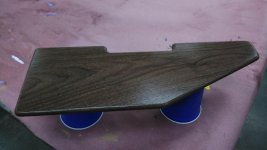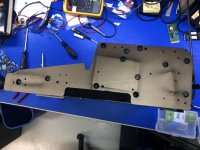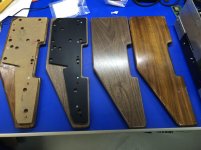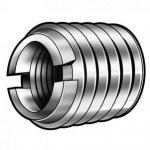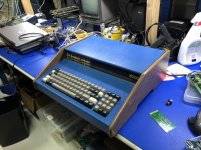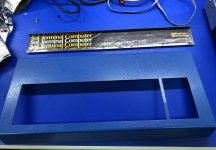dfnr2
Experienced Member
I while back the shelf holding my Sol-20 failed, and the Sol fell 8 feet onto the floor, bouncing off the bench. The machine survived, but the sides were dented and scratched beyond reasonable refurbishment. A forum member kindly offered a set of original sides for a very reasonable price, but I decided to try to recreate them from scratch, with much help from an artist friend who was a furniture maker in a previous life.
I picked up a nice piece of walnut a bit over 1" thick from a local woodworking shop, and after letting it acclimate, re-sawed it into 2 planks a bit over 1/2" thick, which were prepped using the jointer and planer (with lots of help) to produce a matched bookend pair of flat, smooth 1/2" boards for the sides.
Initially, we tried photographing a panel, then correcting the lens distortion, and measuring the holes in the image, transferring the measurements to a 2-D model (in vCarve). Unfortunately, that resulted in incorrect hole placement. So, I created a jig to measure X and Y coordinates using T squares and rulers, and measured the outlines and all the hole positions, correcting the measurements in the 2D design file.
That left me with designs to CNC the walnut outer portion and the masoninte inner portion of the panels. I had a chance to do a little work on them today. I've attached some photos showing
1) In process of routing the edges of the walnut. I used a 1/4" roundoff bit, which I think is a smaller radius than the original, which had slightly pointier curves along the edges, but this gives a nice round edge to the 1/2" walnut, which I think looks better.
2) The routed, unsanded walnut. There's some difference in grain due to the thickness of the boards, but you can see the matched grain patterns of the two pieces cut from a thicker board.
3) In process of sanding the walnut
4) The inner piece of the panel placed next to an original side for comparison. The hole pattern is the same on both sides, even though the right and left sides have the anchors in different positions. The original was made from masonite, but I've CNC'd these from scrap 1/4" plywood. You can see some places where my technique with the flush router around the edges was not optimal.
5) The inner panel compared sitting on top of the original for comparison.
I'll post the finished panels once they are done, and will post the design files when I've verified that the finished panels fit the case.
Dave
I picked up a nice piece of walnut a bit over 1" thick from a local woodworking shop, and after letting it acclimate, re-sawed it into 2 planks a bit over 1/2" thick, which were prepped using the jointer and planer (with lots of help) to produce a matched bookend pair of flat, smooth 1/2" boards for the sides.
Initially, we tried photographing a panel, then correcting the lens distortion, and measuring the holes in the image, transferring the measurements to a 2-D model (in vCarve). Unfortunately, that resulted in incorrect hole placement. So, I created a jig to measure X and Y coordinates using T squares and rulers, and measured the outlines and all the hole positions, correcting the measurements in the 2D design file.
That left me with designs to CNC the walnut outer portion and the masoninte inner portion of the panels. I had a chance to do a little work on them today. I've attached some photos showing
1) In process of routing the edges of the walnut. I used a 1/4" roundoff bit, which I think is a smaller radius than the original, which had slightly pointier curves along the edges, but this gives a nice round edge to the 1/2" walnut, which I think looks better.
2) The routed, unsanded walnut. There's some difference in grain due to the thickness of the boards, but you can see the matched grain patterns of the two pieces cut from a thicker board.
3) In process of sanding the walnut
4) The inner piece of the panel placed next to an original side for comparison. The hole pattern is the same on both sides, even though the right and left sides have the anchors in different positions. The original was made from masonite, but I've CNC'd these from scrap 1/4" plywood. You can see some places where my technique with the flush router around the edges was not optimal.
5) The inner panel compared sitting on top of the original for comparison.
I'll post the finished panels once they are done, and will post the design files when I've verified that the finished panels fit the case.
Dave
Attachments
Last edited:






